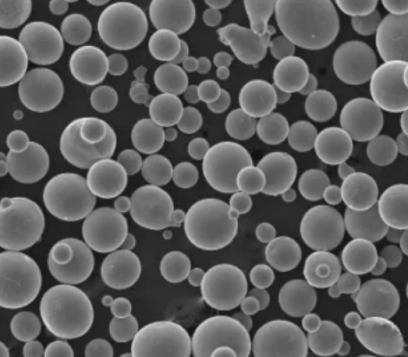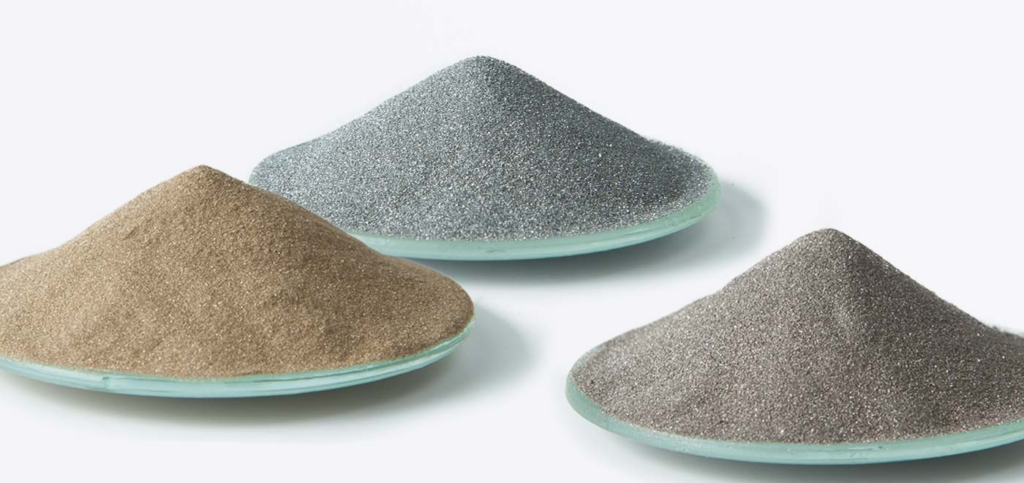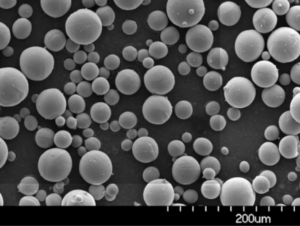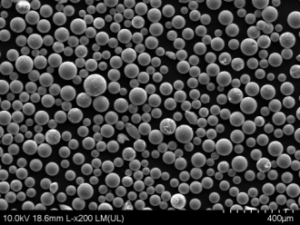銅合金粉 銅粉は製造業や表面加工業において、あらゆる産業で多用途に使われる素材です。このガイドでは様々な銅粉の種類、組成、主な特徴、製造方法、コーティング、プレス、射出成形での使用法、価格、サプライヤーの詳細などを包括的に紹介しています。
銅合金粉末とは?
銅合金粉末は、銅に亜鉛、錫、アルミニウム、ニッケル、シリコン、クロムなどの他の元素を微粒子レベルで組み合わせたものです。ブレンドすることで、熱伝導性、電気伝導性、耐食性、耐摩耗性、硬度といった素材の強さのバランスをとり、最終用途のケース仕様に合わせます。
銅合金の価値を高める主な特性:
- 高い熱伝導性と電気伝導性
- 耐食性
- 耐衝撃性と耐摩耗性
- カスタマイズ可能な機械的特性
- はんだ付け性
- 粉末冶金による製造性
銅を二次金属で調整することで、自動車、海洋、電子機器、防衛など、さまざまな産業で純銅や真鍮粉以外の選択肢が広がります。
銅合金粉末の組成
銅合金の組み合わせや比率は何千通りもあります。一般的な合金とその元素構成は以下の通りです:
| 合金タイプ | 主要コンポーネント |
|---|---|
| 真鍮 | 銅+亜鉛 |
| ブロンズ | 銅+スズ+亜鉛 |
| 銅-ニッケル | 銅+ニッケル |
| キュプロニッケル | 銅+ニッケル+マンガン |
| ノルディック・ゴールド | 銅+亜鉛+アルミ+スズ |
微量元素 鉄、鉛、リン、グラファイト、マグネシウムのような物質が、ある種の合金にも含まれている可能性がある。純度レベルを指定することで、汚染物質をろ過することができます。
合金グレード 例えば、CuZn30は銅70%、亜鉛30%を意味します。比率を変えることで、用途に応じて硬度、強度、融点、導電性を調整することができます。

銅粉末合金の主要特性
銅合金粒子 評価される特徴を示す:
| プロパティ | 貢献 |
|---|---|
| 電気伝導度 | 効率的な熱放散により過熱を防止 |
| 熱伝導率 | 迅速な熱伝導により動作温度を維持 |
| 耐食性 | 風化や大気への暴露に耐える |
| 抗菌性 | 生物静電的な表面活性が微生物を減少させる |
| ノイズ・ダンパー | 振動と音のエネルギーを吸収する |
| 加工性 | 鉄合金よりも柔らかく、加工が容易。 |
| 摩擦抵抗 | 摺動面間の潤滑性維持 |
| スパーク抵抗 | 可燃物周辺での発火リスクを軽減 |
元素比率を変えることで、引張強度、融点、プラッタビリティ、磁性などの特性を調整し、塩分の多い海洋環境から高電圧回路まで、アプリケーションの課題に対応する。
銅合金粉末 製造業
銅合金粉末の商業的な製造方法には次のようなものがある:
| 方法 | 詳細 | 粒子径 |
|---|---|---|
| 霧化 | 溶融金属の流れが紡がれて小さな液滴となり、急速に冷却される | 5μm~150μm |
| カルボニル | 化学反応により純金属が粒子に析出 | 1μm~15μm |
| ローラーミル | 金属を圧縮して平らな薄片に粉砕する | 100メッシュフレーク(~150μm) |
| 電解 | 陽極金属が溶解し、陰極に電解析出する。 | 幅広い分布 |
これらの技術により、産業用途に応じてカスタマイズ可能な、制御された粒度分布を持つ微細な球状、薄片状、または不規則な粒子が得られます。さらにアニール、粉砕、選別、ふるい分けを行うことで、正確な粒子寸法と純度を実現します。
現場での合金化 は、配合に従って構成金属粉末を混合し、成形、3Dプリンティング、射出成形によってネットシェイプの部品に固める。これにより、小規模で特殊な混合物が必要な場合のロジスティクスが簡素化される。
銅粉末合金の用途
銅合金粉末の主な工業用途は以下の通り:
| 申し込み | 詳細 |
|---|---|
| 表面コーティング | 溶射皮膜、PVD、溶接ワイヤ |
| ブッシングとベアリング | オイルフリーの潤滑性、埋め込み性 |
| ろう付け合金 | 金属、セラミックス用接合剤 |
| 射出成形部品 | ネットシェイプの小型部品 |
| プレス・焼結部品 | 構造用ブッシュ、ガイド、スリーブ |
| 3Dプリンティング・フィラメント | 印刷業者向けにカスタマイズ可能なグレード |
| EMIシールド | エレクトロニクスにおける信号の明瞭さ |
| ダイヤモンド工具 | バインダーマトリックス、カッティング補助 |
銅合金のユニークな熱的、電気的、機械的特性は、重機械の摩擦を減らしたり、先端エレクトロニクスのヒートシンクを可能にしたりと、重要なニーズに応えます。
銅合金粉末の仕様
銅粉合金を特徴づける主要なパラメーター:
| 属性 | 代表値 |
|---|---|
| 粒子形状 | 球状、不規則、薄片状 |
| 寸法 | 1ミクロン~150ミクロン |
| サイズ分布 | 10μm以下の割合、53μmなど。 |
| 見かけ密度 | 2~4g/cm3前後 |
| タップ密度 | 材料密度の約70%まで |
| 流量 | 安息角40度 |
| 酸化物含有量 | 3%目標 |
| 汚染限度 | 組成比1 |
粒度分布、純度レベル、粒子形状、見かけ密度、および流量を指定することで、所定の製造プロセス要件に合わせた製造ラン全体で性能の再現性が保証されます。
銅合金パウダー価格
銅合金粒子の価格ドライバーは以下の通りです:
- ベースメタル市場価格
- 純度グレード
- 正確な合金比
- スペシャリティ・コンポジション
- 粒子径と分布
- 注文量とロットサイズ
| タイプ | 価格帯 |
|---|---|
| 銅粉末 | ポンドあたり$5 – $15 |
| 真鍮粉 | ポンドあたり25ドル |
| ブロンズ・パウダー | 6ドル – ポンドあたり30ドル |
| 銅ニッケル粉 | ポンドあたり$15 – $50 |
また、価格設定は製造方法にも左右されます。アトマイズはよりコストがかかりますが、例えば積層造形に適した非常に球状で精製された粉末が得られます。価格設定のニュアンスをさらに説明するために、ここで必要な時間や含有量のようなすべてのパラメータを定量化する。
銅合金粉末のトップサプライヤー
| サプライヤー | 場所 | 備考 |
|---|---|---|
| 金属粉末の製造 | 英国 | 幅広い青銅、黄銅、銅粉 |
| ACuパウダー | 米国 | 銅、ニッケル、スズ合金 |
| 上海CNPC | 中国 | 真鍮、青銅、クロム銅粉 |
| ホーガナス | スウェーデン | ろう付け、表面処理合金 |
これらの大手粉末冶金ベンダーは、標準的なカタログ合金を提供するとともに、世界市場において、所定の生産技術や部品の性能要件に適した組成や粒子仕様をカスタマイズする能力を備えている。
銅合金粉末 長所と短所
銅粒子の利点:
- 高い電気伝導性と熱伝導性
- 耐食性が長寿命を維持
- 抗菌性により生物付着を防止
- 合金鋼よりも柔らかく、加工が容易。
- 相手表面との摩擦を低減
- 希望する特性の比率をカスタマイズ可能
銅粉とのトレードオフには、次のようなものがある:
- 競合合金より一般的に重い
- スチールやアルミニウムよりも高い材料費
- 粒子径が小さいことによる酸化リスク
- 美観のためにより重い仕上げが必要
- EPAの基準値を超える濃度で水生生物に影響を与える。
316Lステンレスやアルミニウムのような代替品に対する総合的なライフサイクルコストを理解することで、有用な長所と、対象用途全体にわたる長期的な使用価値のバランスをとることができます。

よくある質問
Q: 一般的な銅合金粉末にはどのようなものがありますか?
A: 黄銅、青銅、銅-ニッケル、北欧金は、電気的、耐食性、機械的特性のバランスがとれた、広く生産されている合金の代表です。
Q: 銅粉の一般的な粒径はどのくらいですか?
A: 微粒子は、MIMプレスに適した1ミクロンの粉末から、溶射に使用可能な120メッシュのフレークまで、幅広い範囲にわたります。
Q: 銅合金粉末の値段はいくらですか?
A: 価格の幅は、単純な銅で5~15ドル/ポンド、よりエキゾチックな組み合わせで50ドル/ポンドで、ベースメタルの価格、純度、製造方法、注文量に左右されます。
Q: 特殊な銅合金粉末はどこで購入できますか?
A: マキン、ホーガナス、ACuPowderのような大手粉末冶金ベンダーは、一般的なカタロググレードの供給と並行して、カスタムメイドの微粒子製造を可能にしています。
Q: 銅粉の取り扱いにはどのような安全上の注意が必要ですか?
A: 他の卑金属粉末と同様の要件 – 粉塵吸入のリスクを制御するための換気、静電気火花を防止するための接地された機器、汚染防止のための認可された防塵マスクと手袋。
Additional FAQs on Copper Alloy Powder
1) Which copper alloy powder should I choose for high-conductivity thermal management?
Cu–Cr–Zr and Cu–Ni–Si alloys balance conductivity with strength. For maximum conductivity, high‑Cu bronzes or OFHC‑derived copper powders are preferred; for higher softening resistance, Cu–Cr–Zr is common.
2) Can copper alloy powder be used for additive manufacturing (AM)?
Yes. Gas/plasma‑atomized spherical powders with PSD D10–D90 ≈ 15–45 μm are used in laser PBF; green/blue lasers improve absorption for pure Cu. Binder jetting with fine Cu or bronze powders followed by H2 sinter/HIP is increasingly used for larger, lower‑cost parts.
3) How do zinc and tin contents impact performance in brass and bronze powders?
Higher Zn in brass increases strength but reduces corrosion resistance in chlorides; Sn in bronze improves wear and corrosion resistance but lowers conductivity. Tailor content to prioritize either conductivity or durability.
4) What are best practices to limit oxidation in copper alloy powder?
Specify low O2 content (often <0.3 wt% for AM‑grade bronzes; stricter for pure Cu), store in dry inert conditions, minimize exposure during handling, and consider reducing heat treatments (H2/vacuum) before sinter/print.
5) Do copper alloy powders provide antimicrobial performance?
Yes, many Cu‑rich surfaces inactivate bacteria and some viruses rapidly. Validate efficacy per ISO 22196 or EPA protocols; note that surface finish, alloying additions, and oxide state affect kill rates.
2025 Industry Trends for Copper Alloy Powder
- AM-ready copper feedstocks: Wider availability of spherical Cu and Cu‑alloy powders with low oxygen for LPBF; blue/green lasers standard on premium platforms.
- Power electronics cooling: Cu–alloy lattice heat exchangers and vapor chamber interfaces for SiC/GaN modules scale in production.
- EMI/EMC growth: Binder‑jetted Cu–Sn and Cu–Ni housings used for lightweight shielding with corrosion resistance.
- Sustainable sourcing: Higher recycled copper content with material passports and EPDs demanded by OEMs.
- Process integration: Hybrid routes (AM preforms + forging/HIP) deliver conductivity with improved mechanical properties.
| 2025 Metric (Copper Alloy Powder/AM/PM) | Typical Range/Value | Why it matters | ソース |
|---|---|---|---|
| LPBF density (spherical Cu/Cu–alloy, post‑HIP) | 98.5–99.8% | Near‑wrought properties for heat exchangers | OEM app notes; peer‑reviewed AM studies |
| Conductivity (LPBF pure Cu, HIP, blue/green laser) | 70–90% IACS | Motor coils and cold plates | Materials datasheets; lab reports |
| Binder‑jetted Cu/Cu‑alloy final density (sinter/HIP) | 95–99% | Large, lower‑cost shielding and housings | Vendor case data |
| Typical LPBF PSD for Cu/Cu‑alloys | D10–D90 ≈ 15–45 μm | Recoating and melt stability | ISO/ASTM 52907 |
| Indicative price (AM‑grade spherical Cu‑alloys) | $12–$40/kg (brass/bronze); $20–$80/kg (Cu–Cr–Zr, Cu–Ni–Si) | Budgeting and sourcing | Supplier quotes/market trackers |
| Oxygen content (AM‑grade Cu) | ≤0.10 wt% O (target) | Limits porosity/oxidation | OEM specs; ASM references |
Authoritative references and further reading:
- ISO/ASTM 52907 (AM feedstock), 52910 (DFAM): https://www.astm.org and https://www.iso.org
- ASM Handbook: Copper and Copper Alloys: https://www.asminternational.org
- NIST AM resources and data: https://www.nist.gov
- EPA antimicrobial copper information: https://www.epa.gov
Latest Research Cases
Case Study 1: LPBF Cu–Cr–Zr Cold Plate with Conformal Micro‑Channels (2025)
Background: A power electronics OEM needed high‑conductivity cold plates compatible with SiC modules, with low warp and stable flatness.
Solution: Used spherical Cu–Cr–Zr powder (15–45 μm) on a blue‑laser LPBF system; platform preheat, optimized scan vectors; post‑HIP and aging to restore strength; nickel flash on sealing lands.
Results: 21% lower thermal resistance vs. machined Cu baseplate, flatness maintained within 30 μm after 1,000 thermal cycles (−40 to 150°C), leak‑tight at 10 bar; cost per part reduced 18% at series rate.
Case Study 2: Binder‑Jetted Bronze EMI Housings for Avionics (2024)
Background: An avionics supplier sought corrosion‑resistant, conductive housings with reduced machining.
Solution: Binder jetting fine bronze powder; debind, H2 sinter, selective HIP; chromate‑free passivation for salt‑fog durability.
Results: 96–98% density, shielding effectiveness improved by 8–12 dB (10 MHz–1 GHz) vs. aluminum baseline; 30% lead‑time reduction; passed 500 h ASTM B117 salt fog without red rust.
Expert Opinions
- Prof. Alan Luo, Professor of Materials Science and Engineering, The Ohio State University
Key viewpoint: “Cu–Cr–Zr and Cu–Ni–Si offer the best compromise between conductivity and softening resistance for thermal hardware produced from copper alloy powder.” - Dr. Katharina Müller, Head of Surface Engineering, Fraunhofer IFAM
Key viewpoint: “Surface state—oxide chemistry and roughness—governs both corrosion and antimicrobial efficacy on Cu‑alloy parts; post‑treatments must be tuned to the alloy and use case.” - Dr. Brent Stucker, AM Standards Contributor and Industry Executive
Key viewpoint: “Wavelength‑optimized lasers and robust powder specifications have turned copper alloy powder into a production‑grade AM feedstock for heat exchangers and EMI components.”
Citations for expert profiles:
- The Ohio State University: https://www.osu.edu
- Fraunhofer IFAM: https://www.ifam.fraunhofer.de
- ASTM AM Center of Excellence: https://amcoe.org
Practical Tools and Resources
- Standards and qualification
- ISO/ASTM 52907 (feedstock testing), 52910 (DFAM)
- ASTM B214/B212 (sieve/flow), B923 (density), B846 (PM terminology)
- Design and simulation
- Ansys Icepak/Mechanical for electronics cooling and structural checks: https://www.ansys.com
- COMSOL Multiphysics (Heat Transfer, AC/DC): https://www.comsol.com
- nTopology for lattice cold plates and conformal channels: https://ntop.com
- Powder QC and processing
- LECO O/N/H analyzers: https://www.leco.com
- Senvol Database for AM machines/materials: https://senvol.com/database
- HIP and heat‑treat services: https://www.bodycote.com
- Antimicrobial and corrosion guidance
- EPA antimicrobial copper resources: https://www.epa.gov
- ASTM B117 (salt fog) and ISO 22196 (antibacterial activity) references
Last updated: 2025-08-21
Changelog: Added 5 focused FAQs, 2025 trends with metric table and sources, two recent copper alloy powder case studies, expert viewpoints with credible affiliations, and a practical tools/resources list.
Next review date & triggers: 2026-02-01 or earlier if ISO/ASTM feedstock standards change, major OEMs release new blue/green‑laser Cu AM datasets, or copper alloy powder pricing/availability shifts >10% QoQ.

